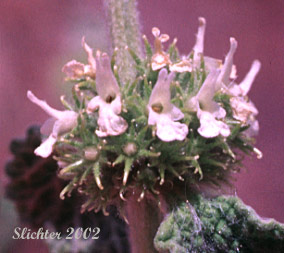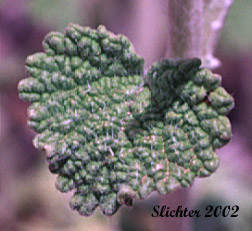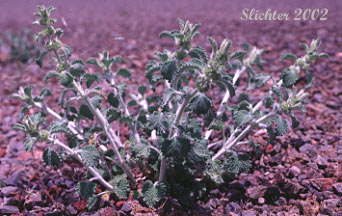

 Characteristics:
Characteristics:
Horehound is a weedy perennial species with several to many prostrate to semi-erect stems from 30-100 cm long. The herbage is conspicuously covered with white-woolly hairs. The leaves are found entirely on the stems where they arise opposite one another. The leaves are relatively the same size all along the length of the stem, with long petioles and with the blades 2-5.5 cm wide and nearly as wide. The blades are broadly elliptic to rotund-ovate with rounded teeth along the margins. The pinnate venation is netted, the areas of the blade around each vein puffed outwards as seen in the photo at right. The surface of the blade is densely woolly haired to slightly haired.
The inflorescence consists of compact, densely-flowered axillary verticels on the upper stems. The calyx tube is 4-5 mm long with 10 narrow lobes at the tip. These lobes appear as stiff yellowish hooks which spread from the tube. The corolla is white or purplish in color and strongly two-lipped. The upper lip is erect and narrowly two-lobed while the lower lip as a broad central lobe flanked by 2 narrow lobes.
Horehound is found in disturbed habitats such as fields, gravel parking lots, and along roadsides.
Horehound is a native of Europe which is now found in disturbed habitats across North America.
In the Columbia River Gorge, it may be found between the elevations of 200'-700' just downstream of the mouth of the Deschutes River.
